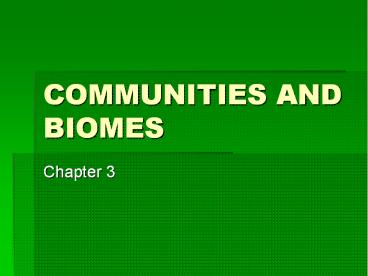COMMUNITIES AND BIOMES - PowerPoint PPT Presentation
Title:
COMMUNITIES AND BIOMES
Description:
COMMUNITIES AND BIOMES Chapter 3 * Prairie, Savannah, Steppe * Jaguar, poison dart frog, ... Marine Biomes = oceans, can be very shallow (surface of ocean) ... – PowerPoint PPT presentation
Number of Views:209
Avg rating:3.0/5.0
Title: COMMUNITIES AND BIOMES
1
COMMUNITIES AND BIOMES
- Chapter 3
2
Communities
- Ch. 3, Sec. 1
3
Communities
- Communities all the interacting living
organisms in an area all the different species - Limiting Factor any biotic or abiotic factor
that restricts population growth
4
- Tolerance ability of an organism to withstand
fluctuations of biotic and abiotic factors
5
Succession
- Succession orderly changes species
replacement of communities in ecosystems
6
- Primary Succession colonization of barren land
by communities of organisms - Pioneer Species are the 1st to arrive
7
- Pioneer species die and decompose adding
nutrients back to the soil - More organisms (insects, fungus, small plants,
etc.) live die adding nutrients back to the
soil - Until eventually.
- Climax Community stable mature community that
changes little
8
- The Indiana Dunes are an example of primary
succession
9
- Secondary Succession sequence of changes after
an existing community is destroyed/damaged a new
community regrows
10
Practice
- Compare and contrast Primary Succession and
Secondary Succession. - Are the starting points the same?
- Are the organisms the same?
11
Biomes
- Ch. 3, Sec. 2
12
Whats a Biome?
- Large group of ecosystems that share the same
type of climax community
13
Aquatic Biomes
- Approx. 75 of Earths surface is covered by
water - Mostly salt water
14
- 1. Marine Biomes oceans, can be very shallow
(surface of ocean) or very deep (bottom of ocean) - Photic Zone portion of marine biome that is
shallow enough for sunlight to penetrate - Aphotic Zone deep water that never receives
sunlight
15
- 2. Estuaries mixture of freshwater ocean
water where rivers meet the ocean
16
- 3. Intertidal Zone portion of shoreline
between high and low tide
17
- 4. Freshwater Biomes lakes, ponds, rivers
18
Terrestrial Biomes
19
- Rainfall varies from biome to biome, resulting in
different adaptations in species
20
- 1. Tundra cold temperatures, short growing
season - Permafrost a layer of permanently frozen soil,
prevents plants from growing deep roots
21
- 2. Taiga cold, conifers (trees that produce
cones)
22
- 3. Desert less than 25cm of annual rainfall
- Adaptations for living in the desert
- Plants spine, waxy coating, toxins
- Animals nocturnal activity, venom, require less
water
23
- 4. Grassland rich soil, trees usually by
bodies of water, lots of grazing animals
24
- 5. Temperate Forests trees lose their leaves
each year
25
- 6. Rain Forests high biodiversity, found in
tropical temperate (moderate climate) areas
26
Practice
- How are organisms in the photic zone and aphotic
zone interdependent? - (Hint Think about what grows in the photic zone,
what supports the base of ecological pyramids?
What happens if a population of one species grows
out of control?)































